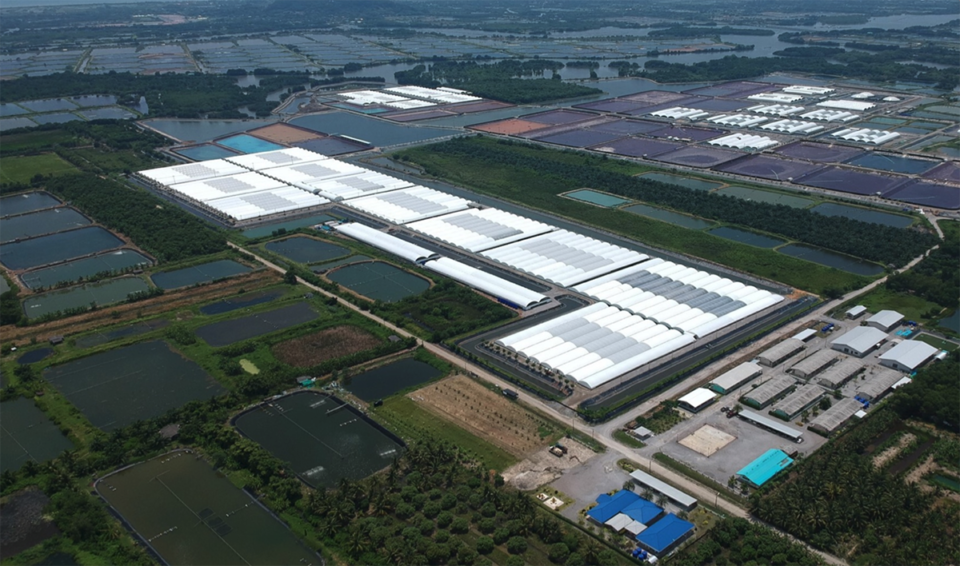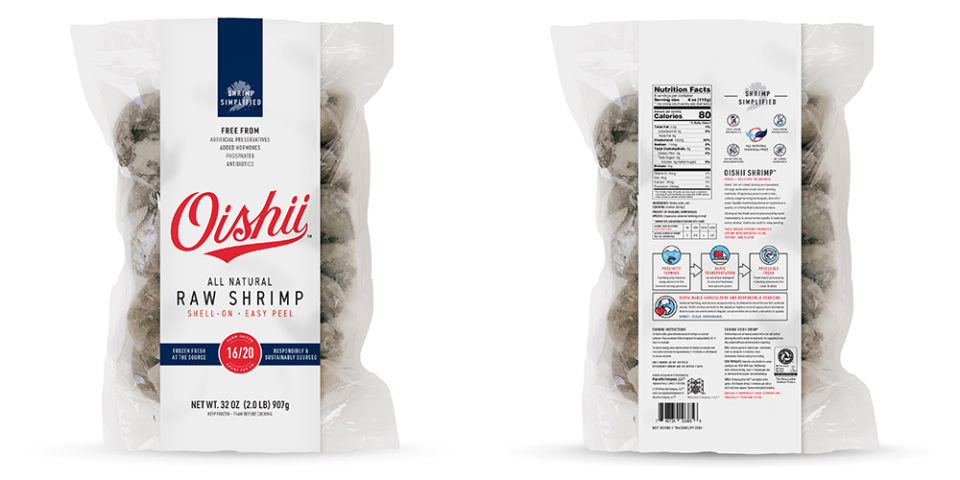Mazzetta Company’s Oishii Shrimp is trucked live shrimp to processing facilities and frozen within hours. Will this catch on?

When Highland Park, Ill.-based Mazzetta company launched Oishii in early January, there were two main points of differentiation for its line of premium vannamei shrimp: a larger-than-usual product and one that’s shipped to the processing plant while still alive.
“We don’t have the water pick-up that shrimp gets when it’s sitting in water dead, and for that reason we get a better flavor, a firmer texture and a more vibrant color,” said Tom Mazzetta, founder and CEO.
Oishii is the Japanese word for delicious. “We chose this name because this product is as close to sushi quality as you can get for shrimp, so the name references the Japanese idea of freshness,” he said.
Such a venture requires a strong supplier partnership. For the past few years, Charoen Pokphand Foods in Bangkok, Thailand, has worked on developing a larger-sized shrimp – 15 shrimp per pound for Oishii, as compared to the industry standard of 16-to-20 shrimp per pound. Oishii shrimp are transported to the processing factories live, which makes the logistics of transportation a lot more complicated and expensive.
“To avoid shrimp damage and mortality the live shrimp must be gradually harvested and the number of shrimp transported at any time is limited to just 30 percent of what we ordinarily transport,” said Premsak Wanuchsoontorn, executive vice-president at CP Foods. “Moreover, the level of oxygen in the water and the temperature needs to be carefully controlled with special tanks during transportation.”
Mazzetta confirmed: “You’re basically hauling a lot of water,” he said. “A typical load of shrimp might contain 10,000 pounds while our aerated trucks might carry 3,000 pounds at most. But because our processing facilities are so close to our farms, we can do more trips with our trucks and keep them going back and forth.
CP Foods’ research revealed that a distance of 150 kilometers would not negatively impact shrimp survival during transportation, but since the company had compatible shrimp farms readily available within a half-hour’s drive of the factories, these were dedicated for Oishii.

The shrimp are frozen within four hours of being removed from water. To date the company has dedicated 30 percent of its total shrimp production to Oishii shrimp, and the harvest cycle lasts four-to-five months.
“This shrimp is unique because it’s fully traceable, it’s free of antibiotics and it’s the largest size of white shrimp available,” Premsak said.
“This product is literally what we would call pure,” Mazzetta said. “There are no preservatives, no antibiotics, no soaking, and no chemicals, hormones or phosphates. We believe consumers are more interested in all-natural products, especially regarding imports coming into the United States.”
The Oishii brand is priced 10 to 15 percent higher than regular shrimp. That’s a tough thing to accept in the shrimp business, Mazzetta said, but customers have accepted it. “Because we’re processing shrimp fresh and working with this new generation of vannamei shrimp, we’re delivering a much more vibrant shrimp compared to what we’ve seen in the past,” he said. “On top of the vibrancy and color, you’re getting a more powerful texture and flavor. And since people eat with their eyes, the visual appeal pulls together nicely with a great taste.”
Oishii shrimp is targeted at retail and foodservice, and while the brand constitutes a small portion of Mazzetta Company’s portfolio to date, Mazzetta said he anticipates it will eventually constitute 10 to 15 percent of total shrimp volume: “[U.S.] per capita consumption of shrimp went up last year again and we want to make sure we’re upping that consumption every year. But unless we make sure we do things correctly and more naturally, we’re all going to lose in the long run. Oishii was motivated by a desire to do things better than everyone else and to create a great experience for shrimp consumers.”
Follow the Advocate on Twitter @GAA_Advocate
Now that you've finished reading the article ...
… we hope you’ll consider supporting our mission to document the evolution of the global aquaculture industry and share our vast network of contributors’ expansive knowledge every week.
By becoming a Global Seafood Alliance member, you’re ensuring that all of the pre-competitive work we do through member benefits, resources and events can continue. Individual membership costs just $50 a year. GSA individual and corporate members receive complimentary access to a series of GOAL virtual events beginning in April. Join now.
Not a GSA member? Join us.
Author
-

Lauren Kramer
Lauren Kramer is a freelance journalist residing in Richmond, B.C., who has written extensively about seafood marketing for SeaFood Business magazine and SeafoodSource.com. Her work appears in a number of publications, including the National Culinary Review and Alaska Airlines Magazine.
Tagged With
Related Posts

Intelligence
Critical decisions for shrimp harvesting and packing, Part 3
In this final installment of Hervé Lucien-Brun’s comprehensive three-part series, the author details the final steps in the process of taking farmed shrimp to the marketplace. Here we take a look at the proper protocols for receiving at the processing plant, weighing, grading and freezing.

Health & Welfare
Stunning methods for fish
Research that has shown fish have the necessary brain structure to feel pain has displaced traditional perspectives and led to additional accounting for fish welfare in aquaculture.

Health & Welfare
Evaluating stunning methods in tropical shrimp aquaculture
Study evaluated effects of stunning methods (thermal shock and electric shock) on the welfare of three crustacean species, including Pacific white shrimp.

Health & Welfare
Fish producers benefit from humane slaughter techniques
EU legislation requires farmed fish be spared unnecessary pain, distress or suffering at slaughter, and efficient manual and automated systems have been developed to help achieve this goal. What’s more, longer shelf life and improved flesh quality have been reported.

